AT: Remove the adapter plate (A) and drive plate (B).
MT: Remove the flywheel.
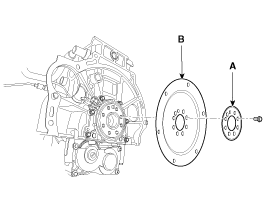
Use fender covers to avoid damaging painted surfaces.
To avoid damaging the cylinder head, wait until the engine coolant temperature drops below normal temperature (20°C [68°F]) before removing it.
When handling a metal gasket, take care not to fold the gasket or damage the contact surface of the gasket.
To avoid damage, unplug the wiring connectors carefully while holding the connector portion.
Mark all wiring and hoses to avoid misconnection.
Turn the crankshaft pulley so that the No. 1 piston is at top dead center.
Remove the engine assembly from the vehicle. (Refer to Engine and transaxle assembly in this group)
Install the engine to engine stand for disassembly.
Remove the intake manifold and exhaust manifold. (Refer to Intake and exhaust system in this group)
Remove the timing chain. (Refer to Timing chain in this group)
Remove the cylinder head. (Refer to Cylinder head in this group)
Remove the high pressure pump. (Refer to FL group)
Remove the water pump assembly. (Refer to Cooling system in this group)
AT: Remove the adapter plate (A) and drive plate (B).
MT: Remove the flywheel.

Remove the encorder (A) and the rear oil seal case assembly (B).

Do not reuse the rear oil seal case assembly.
Do not place a magnatic substance around the encorder.
Be careful not to scratch or damage the encorder by falling down or impacting on.
Keep the encorder from liquid sealant and other harmful materials.
Remove the balance shaft & oil pump module. (Refer to Lubrication system)
Remove the piston and connecting rod assemblies.
Using a ridge reamer, remove all the carbon from the top of the cylinder.
Remove the connecting rod cap (A).
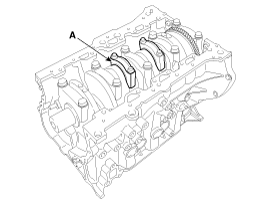
Mark the connecting rod, and caps to be able to reassemble in the original position and direction.
Push the piston and connecting rod assembly with upper bearing through the top of the cylinder block.
Keep the connecting rod ands cap with their bearings assembled together.
Arrange the piston and connecting rod assemblies in the correct order.
Mark the piston and connecting rod assemblies to be able to reassemble in the original position.
Remove the main bearing caps (A) and then lift the crankshaft (B) out of the cylinder block, being careful not to damage journals.
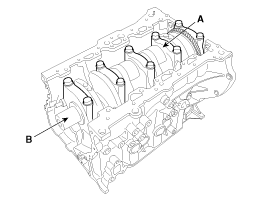
Arrange the main bearings and thrust bearings in the correct order.
Keep the main bearing caps with their bearings assembled together.
Remove the oil jet (A).
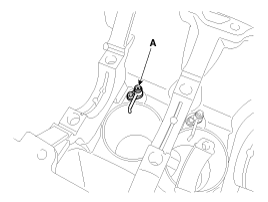
Check fit between piston and piston pin.
Try to move the piston back and forth on the piston pin. If any movement is felt, replace the piston and pin as a set.
Remove the piston rings.
Using a piston ring expender, remove the 2 compression rings (A).
Remove the oil ring and coil spring (B) by hand.
Do not apply excessive force to remove the oil ring from piston. It may cause to break the oil ring.
Arrange the piston rings in the correct order only.
Remove the connecting rod from the piston.
Remove the snap ring (C) from the piston.
Using a press, remove the piston pin from piston.
Disassemble the piston (F) and connecting rod (E).
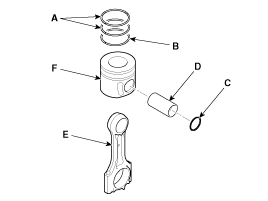
Check the end play between piston and connecting rod.
End play
Standard : 0.05 ~ 0.31mm (0.0020 ~ 0.0122in)
If out-of-tolerance, install a new connecting rod.
If still out-of-tolerance, replace the crankshaft.
Check the connecting rod bearing oil clearance.
Check the match marks on the connecting rod and cap are aligned to ensure correct reassembly.
Remove the 2 connecting rod cap bolts.
Remove the connecting rod cap and lower bearing.
Clean the crankshaft pin journal and bearing.
Place a plastigage across the crankshaft pin journal.
Reinstall the lower bearing and cap, and tighten the nuts.
Tightening torque :
27.5~31.4N.m (2.8~3.2kgf.m, 20.3~23.1lb-ft) + 88°~92°
Do not turn the crankshaft.
Do not reuse the connection rod cap bolts.
Remove the connecting rod cap.
Measure the plastigage at its widest point.
Standard oil clearance
0.024 ~ 0.052mm (0.0009 ~ 0.0020in)

If the plastigage measures too wide or too narrow, remove the upper and lower bearing and then install a new bearings with the same color mark.
Recheck the oil clearance.
Do not file, shim, of scrape the bearings or the caps to adjust clearance.
If the plastigage shows the clearance is still incorrect, try the next larger or smaller bearing.
Recheck the oil clearance.
If the proper clearance cannot be obtained by using the appropriate larger or smaller bearings, replace the crankshaft and start over.
If the marks are indecipherable because of an accumulation of dirt and dust, do not scrub them with a wire brush or scraper. Clean them only with solvent or detergent.
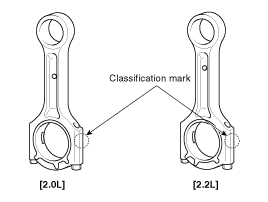
Class (Mark) | Connecting rod big-end inner diameter | |
2.0L | 2.2L | |
A(A) | 51.000 ~ 51.006mm ( 2.0079 ~ 2.0081in) | 55.000 ~ 55.006mm ( 2.1654 ~ 2.1656in) |
B(B) | 51.006 ~ 51.012mm ( 2.0081 ~ 2.0083in) | 55.006 ~ 55.012mm ( 2.1656 ~ 2.1658in) |
C(C) | 51.012 ~ 51.018mm ( 2.0083 ~ 2.0086in) | 55.012 ~ 55.018mm ( 2.1658 ~ 2.1661in) |
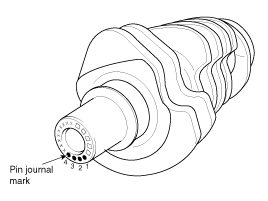
Class (Mark) | Crankshaft pin journal outer diameter | |
2.0L | 2.2L | |
I(A) | 48.012 ~ 48.018mm (1.8902 ~ 1.8905in) | 52.012 ~ 52.018mm (2.0477 ~ 2.0479in) |
II(B) | 48.006 ~ 48.012mm (1.8900 ~ 1.8902in) | 52.006 ~ 52.012mm (2.0475 ~ 2.0477in) |
III(C) | 48.000 ~ 48.006mm (1.8898 ~ 1.8900in) | 52.000 ~ 52.006mm (2.0472 ~ 2.0475in) |

Class (Color) | Connecting rod bearing thickness | |
Upper | Lower | |
A (Blue) | 1.472 ~ 1.477mm ( 0.0580 ~ 0.0581in) | 1.478 ~ 1.481mm ( 0.0582 ~ 0.0583in) |
B (Black) | 1.477 ~ 1.482mm ( 0.0581 ~ 0.0583in) | 1.481 ~ 1.484mm ( 0.0583 ~ 0.0584in) |
C (Red) | 1.482 ~ 1.487mm ( 0.0583 ~ 0.0585in) | 1.484 ~ 1.487mm ( 0.0584 ~ 0.0585in) |
Select the bearing by using selection table.
Connecting rod bearing | Connecting rod mark | |||
A(A) | B(B) | C(C) | ||
Crank shaft pin journal mark | I(A) | A(Blue) | A(Blue) | B(Black) |
II(B) | A(Blue) | B(Black) | C(Red) | |
III(C) | B(Black) | C(Red) | C(Red) | |
Check the connecting rods.
When reinstalling, make sure that cylinder numbers put on the connecting rod and cap at disassembly match. When a new connecting rod is installed, make sure that the notches for holding the bearing in place are on the same side.
Replace the connecting rod if it is damaged on the thrust faces at either end. Also if step wear or a severely rough surface of the inside diameter of the small end is apparent, the rod must be replaced as well.
Using a connecting rod aligning tool, check the rod for bend and twist. If the measured value is close to the repair limit, correct the rod by a press. Any connecting rod that has been severely bent or distorted should be replaced.
Allowable bend of connecting rod :
0.05mm / 100mm (0.0020in / 3.94in ) or less
Allowable twist of connecting rod :
0.1mm / 100mm (0.0039in / 3.94in) or less
Check the crankshaft bearing oil clearance.
To check main bearing-to-journal oil clearance, remove the bearing caps with their lower bearings.
Clean each main journal and lower bearing with a clean shop towel.
Place one strip of plastigage across each main journal.
Reinstall the bearing caps with their lower bearings and bed plate, then tighten the bolts.
Tightening torque :
49.0N.m (5.0kgf.m, 36.2lb-ft) + 120°
Do not turn the crankshaft.
Do not reuse the main bearing cap bolts.
Remove the bearing caps with their lower bearing again, and measure the widest part of the plastigage.
Standard oil clearance :
0.026 ~ 0.044mm (0.0010 ~ 0.0017in)

If the plastigage measures too wide or too narrow, remove the upper and lower bearing and then install a new bearings with the same color mark.
Recheck the oil clearance.
Do not file, shim, or scrape the bearings or the cap to adjust clearance.
If the plastigage shows the clearance is still incorrect, try the next larger or smaller bearing.
Recheck the oil clearance.
If the proper clearance cannot be obtained by using the appropriate larger or smaller bearings, replace the crankshaft and start over.
If the marks are indecipherable because of an accumulation of dirt and dust, do not scrub them with a wire brush or scraper. Clean them only with solvent or detergent.
Cylinder Block Crankshaft Journal Bore Mark Location
Letters have been stamped on the side of block as a mark for the size of each of the 5 main journal bores.
Use them, and the numbers or letters stamped on the crank (marks for main journal size), to choose the correct bearings.
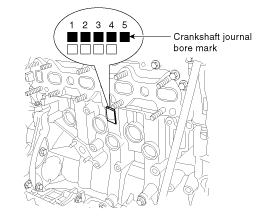
Class (Mark) | Cylinder block journal bore inner diameter |
A(A) | 64.000 ~ 64.006mm ( 2.5197 ~ 2.5199in) |
B(B) | 64.006 ~ 64.012mm ( 2.5199 ~ 2.5202in) |
C(C) | 64.012 ~ 64.018mm ( 2.5202 ~ 2.5204in) |
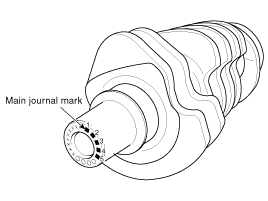
Class (Mark) | Crankshaft main journal outer diameter | |
I(A) | 60.012 ~ 60.018mm ( 2.3627 ~ 2.3629in) | |
II(B) | 60.006 ~ 60.012mm ( 2.3624 ~ 2.3627in) | |
III(C) | 60.000 ~ 60.006mm ( 2.3622 ~ 2.3624in) | |
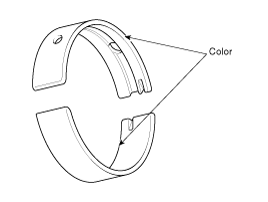
Class (Color) | Crankshaft main bearing thickness | |
A (Blue) | 1.975 ~ 1.978mm ( 0.0778 ~ 0.0779in) | |
B (Black) | 1.978 ~ 1.981mm ( 0.0779 ~ 0.0780in) | |
C (Red) | 1.981 ~ 1.984mm ( 0.0780 ~ 0.0781in) | |
D (Green) | 1.984 ~ 1.987mm ( 0.0781 ~ 0.0782in) | |
E (Yellow) | 1.987 ~ 1.990mm ( 0.0782 ~ 0.0783in) | |
Select the bearing by using selection table.
Crankshaft main bearing | Cylinder block crankshaft journal bore mark | |||
A(A) | B(B) | C(C) | ||
Crankshaft main journal mark | I(A) | A(Blue) | B(Black) | C(Red) |
II(B) | B(Black) | C(Red) | D(Green) | |
III(C) | C(Red) | D(Green) | E(Yelllow) | |
Check the crankshaft end play.
Using a dial indicator, measure the thrust clearance while prying the crankshaft back and forth with a screwdriver.
End play
Standard : 0.07 ~ 0.25mm (0.0028 ~ 0.098in)
Limit : 0.30mm (0.0118in)

If the end play is greater than specification, replace the thrust bearings as a set.
Thickness of thrust bearing :
1.925 ~ 1.965mm (0.0758 ~ 0.0774in)
Inspect the crankshaft main journals and pin journals.
Using a micrometer, measure the diameter of each main journal and pin journal.
Main journal diameter :
60.000 ~ 60.018mm (2.3622 ~ 2.3629in)
Pin journal diameter :
2.0L: 48.000 ~ 48.018mm (1.8898 ~ 1.8905in)
2.2L: 52.000 ~ 52.018mm (2.0472 ~ 2.0479in)
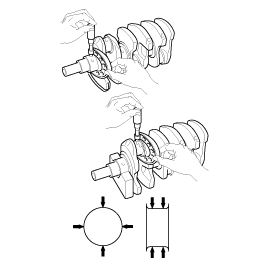
Remove the gasket material.
Using a gasket scraper, remove all the gasket material from the top surface of the cylinder block.
Clean the cylinder block
Using a soft brush and solvent, thoroughly clean the cylinder block.
Inspect the top surface of cylinder block for flatness.
Using a precision straight edge and feeler gauge, measure the surface contacting the cylinder head gasket for warpage.
Flatness of cylinder block gasket surface
Less than 0.05mm (0.0020in)

Inspect the cylinder bore.
Visually check the cylinder for vertical scratchs.
If deep scratchs are present, replace the cylinder block.
Inspect the cylinder bore diameter.
Using a cylinder bore gauge, measure the cylinder bore diameter at position in the thrust and axial direction.
Standard diameter :
2.0L: 84.000 ~ 84.030mm (3.3071 ~ 3.3083in)
2.2L: 85.400 ~ 85.430mm (3.3622 ~ 3.3634in)
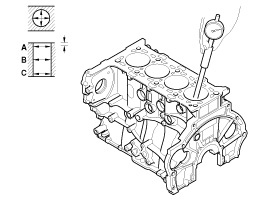
A: 10mm (0.3937in)
B: 80mm (3.1496in)
C: 150mm (5.9055in)
Check the cylinder bore size mark on the side of the cylinder block.
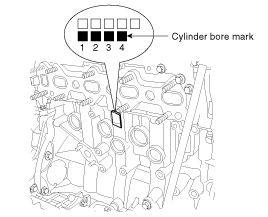
Class (Mark) | Cylinder bore inner diameter | |
2.0L | 2.2L | |
A(A) | 84.000 ~ 84.010mm ( 3.3071 ~ 3.3075in) | 85.400 ~ 85.410mm ( 3.3622 ~ 3.3626in) |
B(B) | 84.010 ~ 84.020mm ( 3.3075 ~ 3.3079in) | 85.410 ~ 85.420mm ( 3.3626 ~ 3.3630in) |
C(C) | 84.020 ~ 84.030mm ( 3.3079 ~ 3.3083in) | 85.420 ~ 85.430mm ( 3.3630 ~ 3.3634in) |
Check the piston size mark on the piston top face.
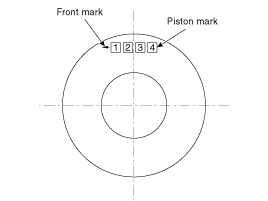
Item | Mark |
1 | Engine - 2 : 2.2L - 0 : 2.0L |
2 | Power - S : Standard - L : Low power |
3 | Piston grade - A - B - C |
4 | Ring - G : For General region - None : Except General region |
Class (Mark) | Piston outer diameter | |
2.0L | 2.2L | |
A(A) | 83.915 ~ 83.925mm ( 3.3037 ~ 3.3041in) | 85.315 ~ 85.325mm ( 3.3626 ~ 3.3630in) |
B(B) | 83.925 ~ 83.935mm ( 3.3041 ~ 3.3045in) | 85.325 ~ 85.335mm ( 3.3630 ~ 3.3596in) |
C(C) | 83.935 ~ 83.945mm ( 3.3045 ~ 3.3049in) | 85.335 ~ 85.345mm ( 3.3596 ~ 3.3600in) |
Select the piston related to cylinder bore class.
Piston-to-cylinder clearance :
0.075 ~ 0.095mm (0.0030 ~ 0.0037in)
Clean the piston.
Using a gasket scraper, remove the carbon from the piston top.
Using a groove cleaning tool or broken ring, clean the piston ring grooves.
Using solvent and a brush, thoroughly clean the piston.
Do not use a wire brush.
The standard measurement of the piston outside diameter is taken 10mm (0.39in) from bottom land of the piston.
Standard diameter :
2.0L: 83.915 ~ 83.945mm (3.3037 ~ 3.3049in)
2.2L: 85.315 ~ 85.345mm (3.3589 ~ 3.3600in)
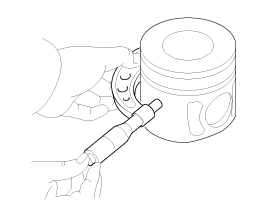
Calculate the difference between the cylinder bore inner diameter and the piston outer diameter.
Piston-to-cylinder clearance :
0.075 ~ 0.095mm (0.0030 ~ 0.0037in)
Inspect the piston ring side clearance.
Using a feeler gauge, measure the clearance between new piston ring and the wall of ring groove.
Piston ring side clearance
No.1 : 0.102 ~ 0.146mm (0.0040 ~ 0.0057in)
No.2 : 0.070 ~ 0.110mm (0.0028 ~ 0.0043in)
Oil ring : 0.030 ~ 0.070mm (0.0012 ~ 0.0028in)
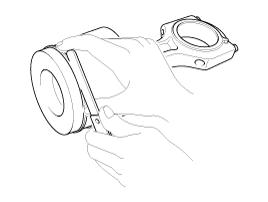
If the clearance is greater than maximum, replace the piston.
Inspect the piston ring end gap.
To measure the piston ring end gap, insert a piston ring into the cylinder bore. Position the ring at right angles to the cylinder wall by gently pressing it down with a piston. Measure the gap with a feeler gauge. If the gap exceeds the service limit, replace the piston rings. If the gap is too large, recheck the cylinder bore inner diameter. If the bore is over the service limit, the cylinder block must be rebored.
Piston ring end gap
No.1 : 0.18 ~ 0.33mm (0.0071 ~ 0.0130in)
No.2 : 0.35 ~ 0.50mm (0.0138 ~ 0.0297in)
Oil ring : 0.25 ~ 0.50mm (0.0098 ~ 0.0197in)

Measure the outer diameter of piston pin.
Piston pin diameter :
33.991 ~ 33.997mm (1.3382 ~ 1.3385in)
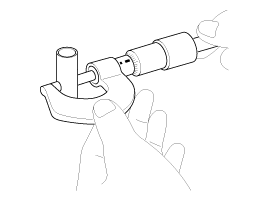
Measure the piston pin-to-piston clearance.
Piston pin-to-piston clearance :
0.007 ~ 0.019mm (0.0003 ~ 0.0007in)
Check the difference between the piston pin outer diameter and the connecting rod small end inner diameter.
Piston pin-to-connecting rod interference :
0.023 ~ 0.041mm (0.0009 ~ 0.0016in)
Thoroughly clean all parts to assembled.
Before installing the parts, apply fresh engine oil to all sliding and rotating surfaces.
Replace all gaskets, O-rings and oil seals with new parts.
Assemble the piston and the connecting rod.
Install the snap ring in one side of the piston pin hole.
Align the piston front mark and the connecting rod front mark.
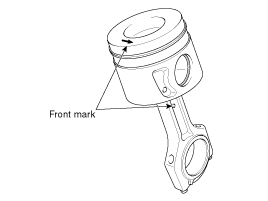
Insert the piston pin into the piston pin hole and the small end bore of connecting rod.
Install the snap ring in the other side after inserting the piston pin.
Apply a sufficient amount of engine oil to outer surface of the piston, inner surface of piston pin hole and small end bore of the connecting rod before inserting the piston pin.
Be careful not to damage and scratch the small end bore, piston pin hole and piston pin when insering the piston pin.
Set the snap ring firmly so that the snap ring can contact with the whole groove of the piston pin hole.
Install the piston rings.
Install the oil ring with the coil spring by hand.
Using a piston ring expander, install the 2 compression rings with the maker mark facing upward.
Position the piston rings so that the ring ends are as shown. (The No.1 ring should be on the opposite side of the No.2 ring and the oil ring should be on the opposite side of the coil spring.)
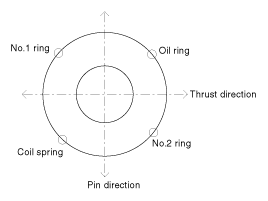
Install the connecting rod bearings.
Align the bearing claw with the groove of the connecting rod or connecting rod cap and install the bearings (A) in the connecting rod and connecting rod cap (B).

Apply a coat of engine oil after assembling the bearings.
Install the crankshaft main bearings.
Upper bearings have an oil groove of oil holes ; Lower bearings do not.
Align the bearing claw with the claw groove of the cylinder block, and push in the 5 upper bearings (A).
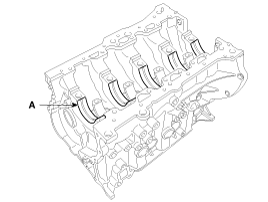
Align the bearing claw with the claw groove of the main bearing cap (B), and push in the 5 lower bearings (A).
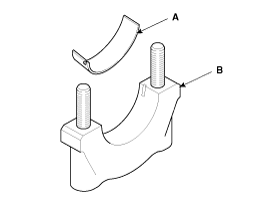
Apply a coat of engine oil after assembling the main bearings.
Install the thrust bearings (No.4 journal).
Install the 2 thrust bearings (B) on both sides of the No.4 journal of the cylinder block with the oil groove (A) facing out.
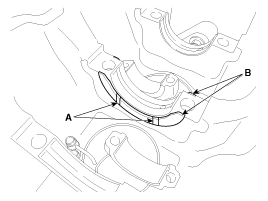
Install the oil jet (A).
Tightening torque :
8.8 ~ 12.7N.m (0.9 ~ 1.3kgf.m, 6.5 ~ 9.4lb-ft)

Place the crankshaft (A) on the cylinder block.
Apply a coat of engine oil to the pin and main journals after assembling the crankshaft.
Install the main bearing caps (B) and tighten the cap bolts.
Do not reuse the bearing cap bolts.
Be sure to assemble the main bearing caps in correct order.
Install the main bearing cap with the arrow facing the front of the engine.
Tighten all the main bearing cap bolts with the specified torque first, and then retighten all the bolts with the specified angle.
Apply a light coat of engine oil on the threads of the bolts.
Tighten all the bolts with the specified torque in numerical order.
Tighten all the bolts with the specified angle in numerical order.
Tightening torque :
49.0N.m (5.0kgf.m, 36.2lb-ft) + 120°
Using the SST (09221-4A000), tighten the bolts.
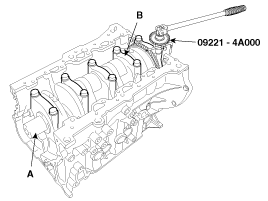
Check that the crankshaft turns smoothly.
Check the crankshaft end play.
Install the piston and connecting rod assemblies.
Before installing the piston, apply a coat of engine oil to the ring grooves and cylinder bores.
Install the pistion and connecting rod assembly with the front marks facing the front of the engine.

Install the ring compressor, check that the rings are securely in place, then position the piston in the cylinder, and tap it in using the wooden handle of a hammer.
Stop after the ring compressor pops free, and check the connecting rod-to-crank journal alignment before pushing the piston into place.
Apply engine oil to the bolt threads. Install the rod caps with bearings, and tighten the bolts.
Tightening torque :
27.5~31.4N.m (2.8~3.2kgf.m, 20.3~33.1lb-ft) + 88°~92°
Using the SST (09221-4A000), tighten the bolts.
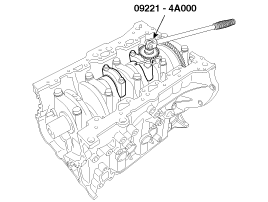
Do not reuse the connecting rod cap bolts.
Maintain downward force on the ring compressor to prevent the rings from expending before entering the cylinder bore.

Check the end play between piston and connecting rod.
Install the balance shaft & oil pump medule. (Refer to Lubrication system in this group)
Install new rear oil seal case assembly and the encorder.
Install the SST (09231-1M200, 09231-H110)(A) on the crankshaft.
Push in the rear oil seal case assembly (B) by hand and then tighten the bolts.
Tightening torque :
9.8 ~ 11.8N.m (1.0 ~ 1.2kgf.m, 7.2 ~ 8.7lb-ft)

Install the encorder (A).

Apply a coat of engine oil around PTFE seal before installing the rear oil seal assembly.
Be careful not to damage and twist the PTFE seal.
Remove harmful materials on the crankshaft flenge and use the SST to prevent the PTFE seal from being damaged and twisted.
Insert the dust cover completely into the slot of the cylinder block and then confirm the assembly with the sensor cable.
Do not reuse the rear oil seal case assembly.
When keeping the SST, keep away from foreign sub stances and be careful not tobe scratched.
When installing the rear oil seal case assembly, do not hold the lip portion.
AT : Install the drive plate (B) and adapter plate (A).
MT : Install the flywheel.
Tightening torque :
117.7 ~ 127.5N.m (12.0 ~ 13.0kgf.m, 86.8 ~ 94.0lb-ft)

Do not reuse the drive plate bolts and flywheel bolts.
Install the water pump assembly. (Refer to Cooling system in this group)
Install the high pressure pump. (Refer to FL group)
Install the cylinder head. (Refer to Cylinder head in this group)
Install the timing chain. (Refer to Timing chain in this group)
Install the intake manifold and exhaust manifold. (Refer to Intake and exhaust system in this group)
Remove the engine from a engine stand.
Install the engine assembly in the vehicle. (Refer to Engine and transaxle assembly in this group)